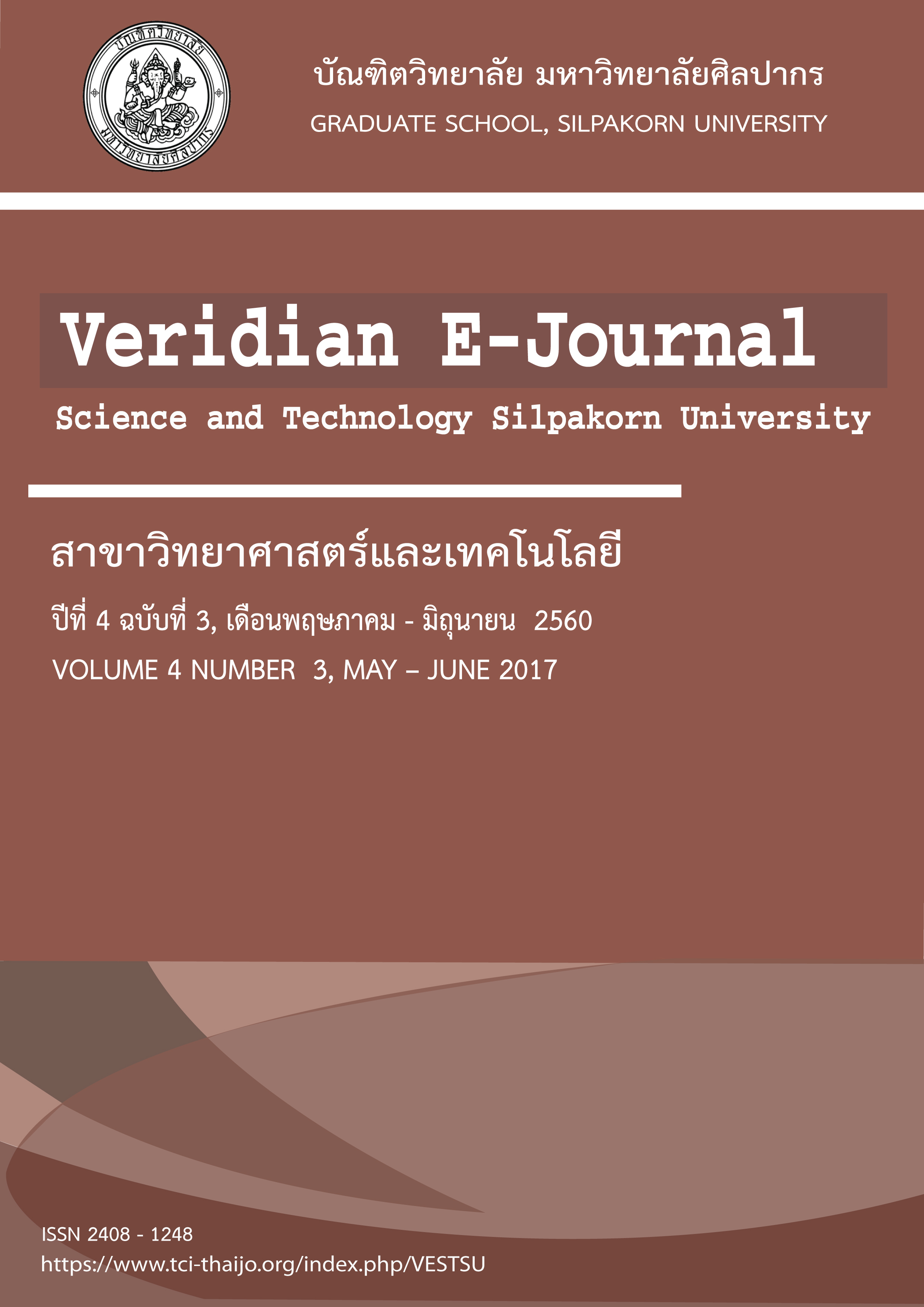การพัฒนาระบบก่อนการจ่ายยาผู้ป่วยในของโรงพยาบาลหลวงพ่อทวีศักดิ์ ชุตินฺธโร อุทิศ กรุงเทพมหานคร
Main Article Content
Abstract
งานวิจัยนี้มีวัตถุประสงค์เพื่อพัฒนาระบบก่อนการจ่ายยาผู้ป่วยในและศึกษาผลของระบบก่อนการจ่ายยาผู้ป่วยในของโรงพยาบาลหลวงพ่อทวีศักดิ์ ชุตินฺธโร อุทิศ โดยวิธีการวิจัยเชิงปฏิบัติการในงานบริการจ่ายยาผู้ป่วยใน กลุ่มงานเภสัชกรรม โรงพยาบาลหลวงพ่อทวีศักดิ์ ชุตินฺธโร อุทิศ กรุงเทพมหานคร ตั้งแต่เดือนตุลาคม-พฤศจิกายน พ.ศ. 2559 ในวันและเวลาราชการ แบ่งวิธีการวิจัย 3 ระยะ ระยะที่ 1 ศึกษากระบวนการทำงานของงานบริการจ่ายยาผู้ป่วยใน ระยะที่ 2 การพัฒนาระบบก่อนการจ่ายยาผู้ป่วยในจากการระดมความคิดและสนทนากลุ่ม ระยะที่ 3 ทดลองปฏิบัติและประเมินผล โดยเก็บข้อมูลจากสำเนาใบสั่งแพทย์ทุกใบ จำนวนสำเนาใบสั่งแพทย์ก่อนปรับปรุงระบบ 11,384 ใบ (ช่วงเดือนมิถุนายน-กรกฎาคม 2559) หลังปรับปรุงระบบ 11,442 ใบ (ช่วงเดือนตุลาคม-พฤศจิกายน 2559) และใช้สถิติ independent t-test ในการเปรียบเทียบ
ผลการศึกษาพบว่าในระบบงานเดิมขั้นตอนที่เกิดความคลาดเคลื่อนมากที่สุดคือขั้นตอนจัดยาร้อยละ 55 การพัฒนาระบบการทำงานจากการระดมความคิดและสนทนากลุ่ม สรุปได้ 5 มาตรการในการปรับปรุง 1) การจัดทำระบบเตือนเพื่อแก้ไขปัญหาการจ่ายยารูปคล้ายเสียงพ้อง โดยงานจัดซื้อยาและเวชภัณฑ์รับผิดชอบกำหนดนโยบายไม่จัดซื้อจัดหายารูปคล้ายเสียงพ้อง การจัดทำรายการยารูปคล้ายเสียงพ้อง การใช้อักษรแบบ Tall man letter ที่เป็นรูปแบบเดียวกันทั้งโรงพยาบาล ออกจดหมายเตือนเผยแพร่ให้บุคลากรทราบ 2) การปรับปรุงทะเบียนชื่อยาในคอมพิวเตอร์กรณียาที่มีหลายความแรง โดยงานวิชาการเภสัชกรรมปรับปรุงทะเบียนชื่อยาในคอมพิวเตอร์ใช้การเตือนจากคอมพิวเตอร์ทำให้เกิดความแตกต่าง ส่วนหน่วยงานบริการจ่ายยาผู้ป่วยในมอบหมายงานให้เจ้าพนักงานเภสัชกรรมดำเนินการปรับปรุงป้ายชื่อยา 3) การสร้างระบบการจัดยา โดยงานบริการจ่ายยาผู้ป่วยในรับผิดชอบการเรียงลำดับรายการยาบนชั้นเก็บยา กำหนดขั้นตอนการจัดยาให้อ่านชื่อยาให้ครบถ้วนก่อนหยิบยา ขณะจัดยา หลังจัดยา และลงชื่อผู้ปฏิบัติงานทุกครั้ง 4) การสร้างระบบการตรวจสอบแบบบันทึกการใช้ยาซ้ำโดยเภสัชกร 5) การจัดเจ้าหน้าที่ปฏิบัติงานทดแทนกรณีเจ้าหน้าที่ห้องจ่ายยาผู้ป่วยใน ขาด/ลา/ประชุม โดยดำเนินการทั้ง 5 มาตรการพร้อมกันระหว่างวันที่ 1 ตุลาคม-30 พฤศจิกายน พ.ศ. 2559 ในวันและเวลาราชการ หลังการปรับปรุงระบบงาน พบว่า ความคลาดเคลื่อนก่อนการจ่ายยาของงานบริการจ่ายยาผู้ป่วยใน(มีค่าเฉลี่ย 8.83+2.99 ครั้ง เทียบกับ 3.55+1.66 ครั้ง) ลดลงอย่างมีนัยสำคัญทางสถิติ (p<0.01) ขั้นตอนป้อนข้อมูลลงในคอมพิวเตอร์ (มีค่าเฉลี่ย 2.43+1.71 ครั้ง เทียบกับ 1.13+0.91 ครั้ง) ลดลงอย่างมีนัยสำคัญทางสถิติ (p<0.01) ขั้นตอนจัดยา (มีค่าเฉลี่ย 5.55+2.18 ครั้ง เทียบกับ 2.20+1.62 ครั้ง) ลดลงอย่างมีนัยสำคัญทางสถิติ (p<0.01) และขั้นตอนลงข้อมูลในแบบบันทึกการใช้ยาของผู้ป่วย (มีค่าเฉลี่ย 0.85+0.95 ครั้ง เทียบกับ 0.23+0.42 ครั้ง) ลดลงอย่างมีนัยสำคัญทางสถิติ (p<0.01) สรุปได้ว่าการพัฒนาระบบการจ่ายยาผู้ป่วยในสามารถลดอุบัติการณ์ความคลาดเคลื่อนก่อนการจ่ายยาได้แต่ต้องติดตามรายงานผลอย่างต่อเนื่องและประเมินผลเป็นระยะเพื่อให้เกิดความปลอดภัยด้านยาสูงสุด
The purposes of this thesis were to develop the pre-dispensing system and to study the result of the system toward the medication error in the in-patient department at Luangpho Thaweesak Hospital, Bangkok. The action research was conducted from October to November, 2016 in an official working hour from 8 a.m.-4 p.m. There were three study phases: 1) study the working process of in-patient dispensing services, 2) develop the pre-dispensing system in the in-patient pharmacy department through brainstorming along with group discussion, and a focus group, and 3) implement and evaluate the actions. All in-patient prescriptions; 11,384 copies before developing the system (June to July), and 11,442 copies after developing the system (October to November) were gathered. The data were analyzed and compared with the independent t-test.
The most error process was found in medicine preparation (55%), and of those was the preparation of incorrect medicine type (40%). Five improvements of pre-dispensing system were proposed and implemented simultaneously during October 1–November 30, 2016. First, LASA (Look-Alike, Sound-Alike) guidance, the tall-man letter system, and a warning letter circulation were used to build the awareness system. Second is improving the list of medicines in the computer system. Pharmacy technicians were also assigned to change the name tags of medicines on the shelf especially those have many strengths. Third was renovating the preparation process e.g., re-organizing the medicines on the shelf, triple readings on a medicine label (before, during, and after opening the medicine bottles) before finishing drug preparation, and signing the technician’s name after preparation. Fourth was creating the rechecking system of repeated medicines by a pharmacist. Finally, improving the manpower and human resources management e.g., allocating other personnel to replace the work if someone is missing (e.g., absence, sick-leave, conference attendances).
Pre-dispensing errors of in-patient dispensing services decreased significantly while compared between before and after implementations i.e., medication error (8.83+2.99 vs. 3.55+1.66, p<0.01), data processing into computer (2.43+1.71 vs. 1.13+0.91, p<0.01), medicines preparation (5.55+2.18 vs. 2.20+1.62, p<0.01), and the patient record of medicine uses (0.85+0.95 vs. 0.23+0.42, p<0.01). In conclusion, the development of an in-patient dispensing system reduced the pre-dispensing errors; however, continuous assessment and further study may be needed to maximize the patient safety.

